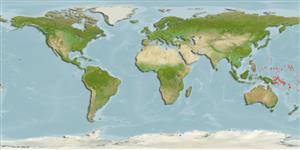Classification / Names
Common names | Synonyms | Catalog of Fishes (gen., sp.) | ITIS | CoL | WoRMS | Cloffa
Actinopterygii (ray-finned fishes) >
Perciformes (Perch-likes) >
Xenisthmidae (Collared wrigglers)
Etymology: Paraxenisthmus: Greek, para in the side of + Gree, xenos = strange + Greek, isthmos = narrow passage (Ref. 45335); cerberusi: Named for Cerberus, the three-headed dog guarding the gates of Hades; refers to the relatively toothy attributes of the genus, and to the black juveniles and red and black adults, colors often associated with the darkness and flames of Hell.. More on author: Winterbottom, Gill.
Environment / Climate / Range
Ecology
Marine; demersal; depth range 12 - 26 m (Ref. 56733). Tropical, preferred ?
Western Central Pacific: Palau.
Size / Weight / Age
Maturity: Lm ? range ? - ? cm
Max length : 2.1 cm SL male/unsexed; (Ref. 56733); 2.1 cm SL (female)
Short description
Morphology | Morphometrics
Dorsal
spines
(total): 7;
Dorsal
soft rays
(total): 11;
Anal
spines: 1;
Anal
soft rays: 10. Diagnosis: Distinguished from its congeners in having 15-16 pectoral fin-rays (vs. 18); cephalic lateralis pore P absent (vs. present); head, nape, ventral abdomen, and dorsal midline of caudal peduncle naked (vs. scaled); and caudal peduncle with a large, black blotch (vs. none) (Ref. 56733).
Small, sand-diving gobioids; inhabits drop-off with caves and ledges, silty sandy shelves and slopes, with hydroids, sea fans and a variety of hard corals and some Halimeda (Ref. 56733).
Life cycle and mating behavior
Maturity | Reproduction | Spawning | Eggs | Fecundity | Larvae
Winterbottom, R. and A. Gill, 2006. Paraxenisthmus cerberusi, a new species of xenisthmid fish from Palau (Percomorpha: Gobioidei). Copeia 2006(1):10-13. (Ref. 56733)
IUCN Red List Status (Ref. 115185)
CITES (Ref. 94142)
Not Evaluated
Threat to humans
Harmless
Human uses
More information
Common namesSynonymsMetabolismPredatorsEcotoxicologyReproductionMaturitySpawningFecundityEggsEgg development
Age/SizeGrowthLength-weightLength-lengthLength-frequenciesMorphometricsMorphologyLarvaeLarval dynamicsRecruitmentAbundance
ReferencesAquacultureAquaculture profileStrainsGeneticsAllele frequenciesHeritabilityDiseasesProcessingMass conversion
Tools
Special reports
Download XML
Internet sources
